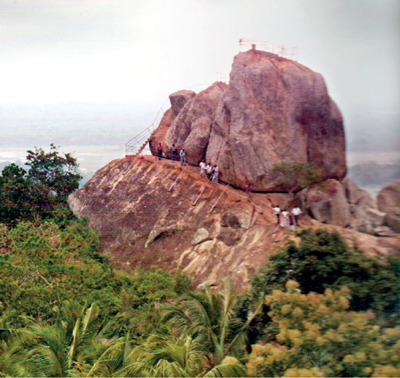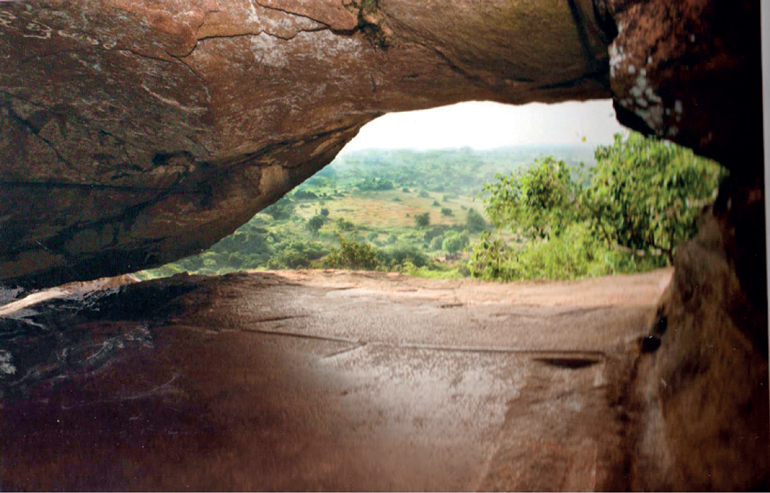Saturday Apr 19, 2025
Saturday Apr 19, 2025
Saturday, 18 June 2016 00:00 - - {{hitsCtrl.values.hits}}

Arahant Mahinda

By D.C. Ranatunga
The King is at the Missaka hill a little away from Anuradhapura, the capital from where he reigned. While hunting he sees a yellow-robed Saint on top of the hill. ‘Tissa, Tisa’ – the Saint addresses the King. He is surprised – the monarch is called by his name. He leaves the bow and arrow aside. They have a short conversation. The Saint had bought Buddhism to Sri Lanka. In his team are three other members of the clergy and a lay follower.
That’s how King Tissa (later called Devanampiya Tissa) met Arahant Mahinda on the Poson Poya day –the full moon day in May/June - in mid-3rd century BC. Missaka Pabbata, as the hill was known was Mihintale eight miles east of Anuradhapura.
Conversion to Buddhism
In ‘The Concise History of Ceylon’, Professor Senerat Paranavitana states that the accounts of the conversion of the King and people of Sri Lanka to Buddhism, written by monks after the religion had secured for itself dominance over the minds of the people, are overlaid with edifying legends in which the miraculous element is conspicuous.
“Mahinda and his companions transport themselves by air from Vessagiri to Mihintale, gods are at hand to make smooth the path of the religious teachers, and impress the multitude with the efficacy of their doctrines. Earthquakes which do no harm to anyone vouch for the veracity of the prophesies ascribed to the Saint. At sermons preached on important occasions, the Devas in the congregation far outnumber the humans. Elephants, without anybody’s bidding, indicate to the King the exact spots on which sacred shrines are to be sited.”
He adds that in spite of this legendary overlay, the fact that Buddhism was accepted by the people and ruler of Sri Lanka is attested by the presence at Mihintale and Anuradhapura of epigraphical and other monuments of a Buddhist character attributable to that period.

Arahant Mahinda’s sermon
Having observed that the King was intelligent enough to grasp the doctrine, Arahant Mahinda preached a sermon to the King and his retinue. Scholar monk, Venerable Dr. Walpola Rahula in his ‘History of Buddhism in Ceylon’ describes the sermon which was based on the ‘Culahatthipadopama sutta’ thus: “The sutta gives a clear idea of the Buddha, Dhamma and Sangha, and describes how one is converted to Buddhism and becomes a bhikkhu. It also describes in detail the simple and holy life of a bhikkhu, the sublime qualities he practises and possesses, the things from which he abstains, the various stages of development of his life and his attainment of arahantship which is the final fruit of Buddhism. The sutta contains almost all the principal teachings of the Buddha as the Four Noble Truths.”
Having listened to the discourse, the King along with his fellow-men embraced Buddhism. Before leaving, he invited Arahant Mahinda to come to the city, which the Thera did the following day.
In Anuradhapura, Arahant Mahinda while residing at the Mahamegha Park – ‘Mahamevuna Uyana’ – preached the Dhamma on several days when thousands gladly accepted the faith. Many entered the Order and the King granted the park to the Sangha to reside.
As Paranavitana describes, “The consecrated boundaries were fixed by the King himself ploughing a furrow to mark them and so as to include the city within them.” Thus was established the Mahavihara which became a celebrated centre of Buddhist teaching.
Mihintale
Meanwhile, caves were prepared at Mihintale for the monks to spend the ‘vas’ – rains retreat when monks reside in one place for the three-month rainy season. This marked the beginning of the ‘Cetiyagiri-Vihara’, another great monastic institution of Buddhism.
Mihintale thus became a holy place with the Buddhists who throng there to worship during Poson Poya. The rock from where the party was seen came to be known as ‘Aradhana Gala’ and the spot from where he delivered the first sermon is marked by the Ambastala dagaba.
The relics of Mahinda are enshrined in the dagaba. It had been built in the ‘vatadage’ style with a terrace round it and adorned with pillars round it. The place is reached by climbing 1,840 granite slabs arranged in four flights. The climb is not strenuous because the steps are in close proximity to one another and quite broad. The ‘araliya’ trees on either side provide a soothing shade.
Passing the Ambastala dagaba a path takes the devotees down to a valley and to a steep rock wall. There the ‘Mihindu guhave’ – the cave where Arahant Mahinda relaxed is preserved to this day. It is well sheltered with a natural stone arch giving protection to the smooth flat stone bed.
Back to the area of the dagaba and proceeding along another set of steps is the Kantaka Chaitya which has been well conserved. It is 40 feet high with a circumference of 425 feet at the base. A highlight of the Chaitya is the ‘vahalkada’ – the elaborately-carved frontispiece, which Dr. Paranavitana considers as its most important architectural feature.
The Maha Seya dagaba where a hair relic of the Buddha has been enshrined stands out at the hilltop.
In the Mihintale premises are a number of ruins including inscriptions, foundations and pillars of halls where monks gathered and where the alms were served, ponds and troughs of stones where water was stored.
In Anuradhapura the King, realising the need for the people to worship, built a stupa and enshrined the collar-bone relic. The Thuparama Chaitya thus became the first stupa to be built in Sri Lanka.